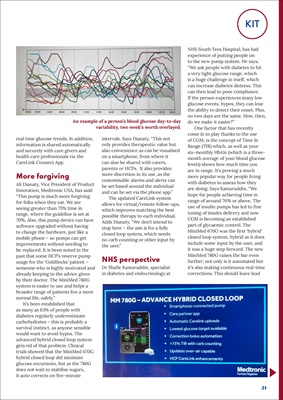
21
KIT
real time glucose trends. In addition,
information is shared automatically
and securely with care givers and
health care professionals via the
CareLink Connect App.
More forgiving
Ali Dianaty, Vice President of Product
Innovation, Medtronic USA, has said:
"This pump is much more forgiving
for folks when they eat. We are
seeing greater than 75% time in
range, where the guideline is set at
70%. Also, this pump device can have
software upgraded without having
to change the hardware, just like a
mobile phone - so pumps can get
improvements without needing to
be replaced. It is been noted in the
past that some HCP's reserve pump
usage for the 'Goldilocks' patient -
someone who is highly motivated and
already keeping to the advice given
by their doctor. The MiniMed 780G
system is easier to use and helps a
broader range of patients live a more
normal life, safely."
It's been established that
as many as 63% of people with
diabetes regularly underestimate
carbohydrates - this is probably a
survival instinct, as anyone sensible
would want to avoid hypos. The
advanced hybrid closed loop system
gets rid of that problem. Clinical
trials showed that the MiniMed 670G
hybrid closed loop did minimise
glucose excursions, but as the 780G
does not wait to stabilise sugars,
it auto corrects on five-minute
intervals. Says Dianaty, "This not
only provides therapeutic value but
also convenience as can be visualised
on a smartphone, from where it
can also be shared with carers,
parents or HCPs. It also provides
more discretion in its use, as the
customisable alarms and alerts can
be set based around the individual
and can be set via the phone app."
The updated CareLink system
allows for virtual/remote follow-ups,
which improves matching the best
possible therapy to each individual.
Adds Dianaty, "We don't intend to
stop here - the aim is for a fully
closed loop system, which needs
no carb counting or other input by
the user."
NHS perspective
Dr Shafie Kamaruddin, specialist
in diabetes and endocrinology at
NHS South Tees Hospital, has had
experience of putting people on
to the new pump system. He says,
"We ask people with diabetes to hit
a very tight glucose range, which
is a huge challenge in itself, which
can increase diabetes distress. This
can then lead to poor compliance.
If the person experiences many low
glucose events, hypos, they can lose
the ability to detect their onset. Plus,
no two days are the same. How, then,
do we make it easier?"
One factor that has recently
come in to play thanks to the use
of CGM, is the concept of Time In
Range (TIR) which, as well as your
six-monthly HbA1c (which is a threemonth
average of your blood glucose
levels) shows how much time you
are in range. It's proving a much
more popular way for people living
with diabetes to assess how they
are doing. Says Kamaruddin, "We
hope for people achieving time in
range of around 70% or above. The
use of insulin pumps has led to fine
tuning of insulin delivery and now
CGM is becoming an established
part of glycaemic control. The
MiniMed 670G was the first 'hybrid'
closed loop system, hybrid as it does
include some input by the user, and
it was a huge step forward. The new
MiniMed 780G raises the bar even
further; not only is it automated but
it's also making continuous real-time
corrections. This should leave lead
An example of a person's blood glucose day-to-day
variability, two week's worth overlayed.